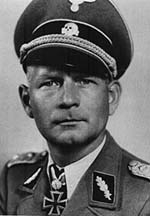7.SS-Freiwilligen-Gebirgs-Division “Prinz Eugen”
Lineage
| ||||||||||||||||||||||||||||||||||||||||||||||||||||||||||||||||||||||
TraditionsThe title Prinz Eugen comes from the German spelling of the name Francois Eugene, Prince of Savoy, who lived from 1663 to 1736. Born in Paris, France, Eugene is known to history as being one of the greatest European soldiers of all time. After being refused a commission in the French army by King Louis XIV, Eugene entered the service of the Holy Roman Emperor Leopold I in 1683, to fight against the Ottoman TurksMade field marshal in1693, Prince Eugene was the commander and diplomat who led the military campaigns that would lay the foundations for Habsburg power in central Europe. He fought the Turks at Vienna and helped to establish the Austrio-Hungarian empire. He also fought against France in two wars, and while in command of the imperial army he helped Marlborough in several battles during the War of the Spanish succession. Later, Prince Eugene won several further victories against the Turks, capturing Belgrade in1718. | ||||||||||||||||||||||||||||||||||||||||||||||||||||||||||||||||||||||
History
In the early months of the Divisions History, it was found struggling to fill its ranks through the use of volunteers alone, and soon conscription was used to finish the Division, eventually gaining some 21,500 members. The 7th Division of the SS was designed for anti-partisan warfare in the Balkan region, and it was during such operations in October 1942, that theDivision first saw action near the Serbian-Montenegro border in mountains east of the Ibar River. Soon after this action, the Division was transferred to the Zagreb-Karlovac area and took part in Operation White with other German units. Operation White was one of the many major anti-partisan operations in the Balkan Region aimed at destroying Tito’s resistance movement. This operation proved to be a failure though, and Tito’s forces managed to evade the brunt of the German offensive. Throughout the next few months, the Division was placed under Army Group E, and in May 1942, the Division took part in more anti-partisan operations, this time during Operation Black. After Black, elements of the Division were sent to North of Sarajevo, and later, the Division was sent to Mostar. Next, the Division saw service on the Dalmation Coast while disarming Italian soldiers in September 1943. After helping to disarm Italians, the 7th SS helped occupy the Brac, Hvar, and Korcula Islands and the PeljesacPeninsula. In December 1943, the 7th SS once more was in action against Tito’s forces, and once more, the actions proved less-than-promising. In January 1944, the 7th SS Division was transferred to the Split, Dubrovnik area for more training at which time the Division was also reorganized. Prinz Eugen was transferred back to the Bosnia area in March 1944 and continued its part in anti-partisan operations. In May 1944, the 7th fought again against Tito’s partisans near Drvar. Next, the Division was moved and fought against Russian and Bulgarian units in August 1944. At this time, the Division suffered greatly and took a good deal of casualties. In September 1944, the Division saw action in what was probably its most important role so far. Prinz Eugen, along with elements of other Waffen SS units helped to hold a vital bridgehead in the Vardar Corridor in Macedonia so as to help 350,000 German soldiers escape from possible encirclement by the advancing Soviets. The 350,000 German soldiers were attempting to move north from occupation duties in the Aegean and Greek regions of the Balkans. Prinz Eugen was badly mauled, but the operation proved to be a success. After helping hold the line in the Vardar corridor, the Division took part in many rear-guard actions resulting in a long retreat from Cacak all the way to Brcko and over the Drina. In January 1945, the Division fought partisans near Otok and later was sent to the area of Vukovar where it fought again against advancing Soviet forces, and Tito’s partisans. From February 1945 to April 1945, the Division was in action against the Partisans and the Soviets, finally ending the War in Slovenia and being taken by the Yugoslav government. | ||||||||||||||||||||||||||||||||||||||||||||||||||||||||||||||||||||||
Organization
| ||||||||||||||||||||||||||||||||||||||||||||||||||||||||||||||||||||||
CommandersObergruppenführer Arthur Phelps, 1.30.42 – 5.15.43  Brigadeführer August Schmidthuber, 1.20.45 – 5.8.45 | ||||||||||||||||||||||||||||||||||||||||||||||||||||||||||||||||||||||
War Service
|

 After a fairly long process of attempting to form an SS Division from the rather large Volksdeutsche community living outside of Germany, and not to merely incorporate them into other various Wermacht units, Gottlob Berger (As head of the SS recruiting office) managed to help secure the 7thDivision of the ss. The 7th Division of the SS was formed from the Volksdeutsche living in the Serbian and Croatian areas of Yugoslavia through volunteers, and then through conscription. The Division was initially established in March of 1942 from a SS Selbstschutz (SS ProtectionForce) and the Einsatz-Staffel (Also called Prinz Eugen) from Croatia.
After a fairly long process of attempting to form an SS Division from the rather large Volksdeutsche community living outside of Germany, and not to merely incorporate them into other various Wermacht units, Gottlob Berger (As head of the SS recruiting office) managed to help secure the 7thDivision of the ss. The 7th Division of the SS was formed from the Volksdeutsche living in the Serbian and Croatian areas of Yugoslavia through volunteers, and then through conscription. The Division was initially established in March of 1942 from a SS Selbstschutz (SS ProtectionForce) and the Einsatz-Staffel (Also called Prinz Eugen) from Croatia.